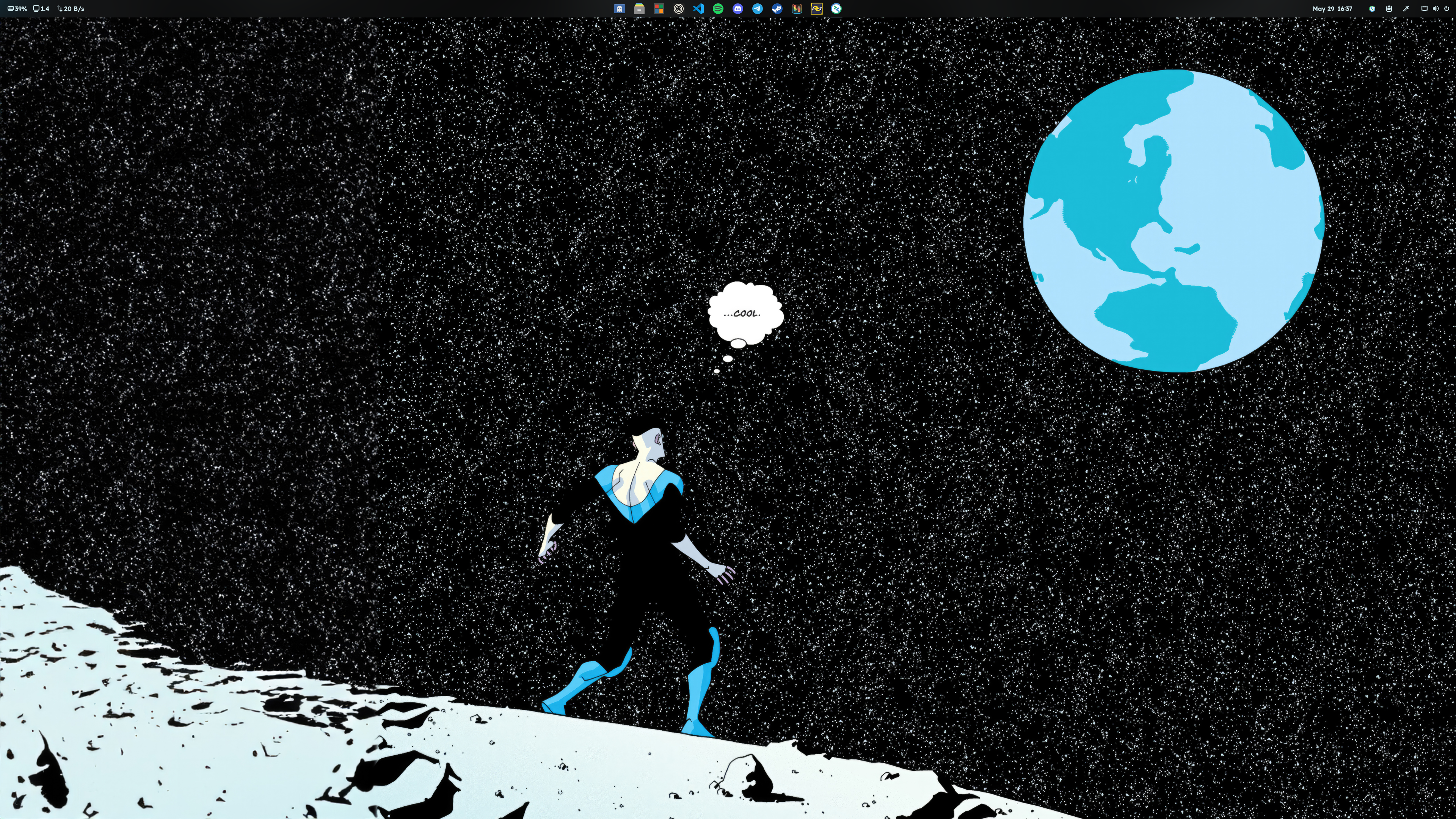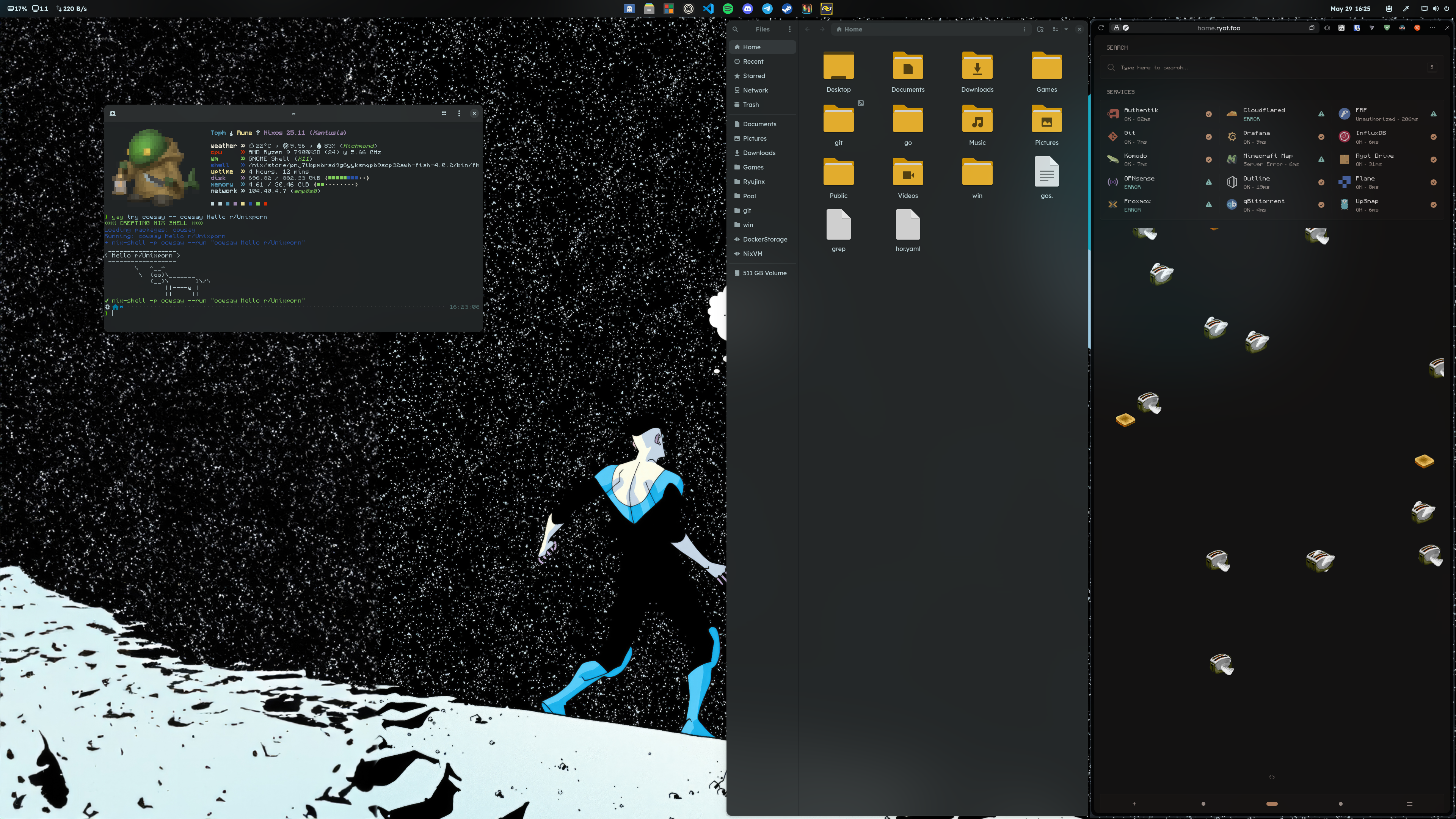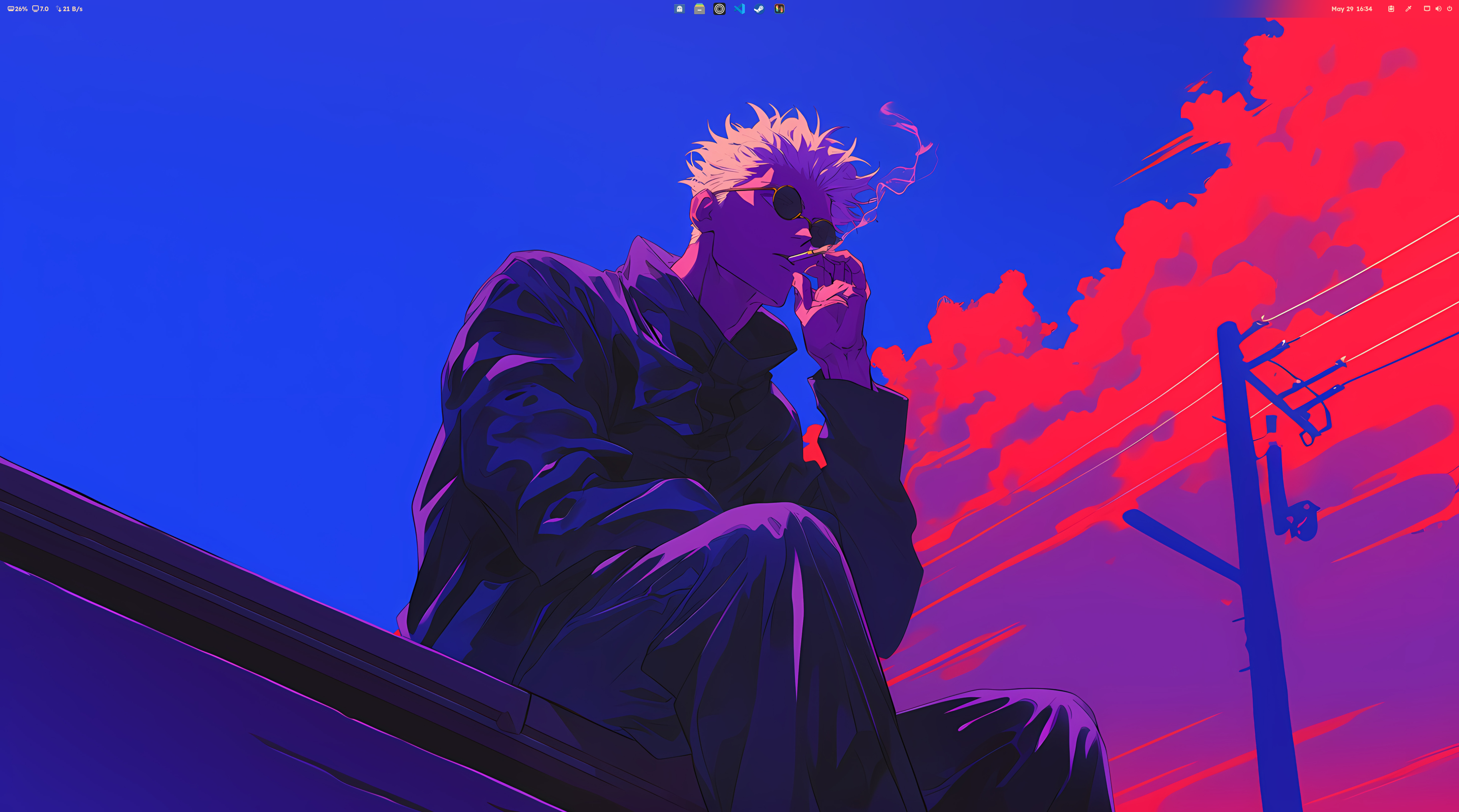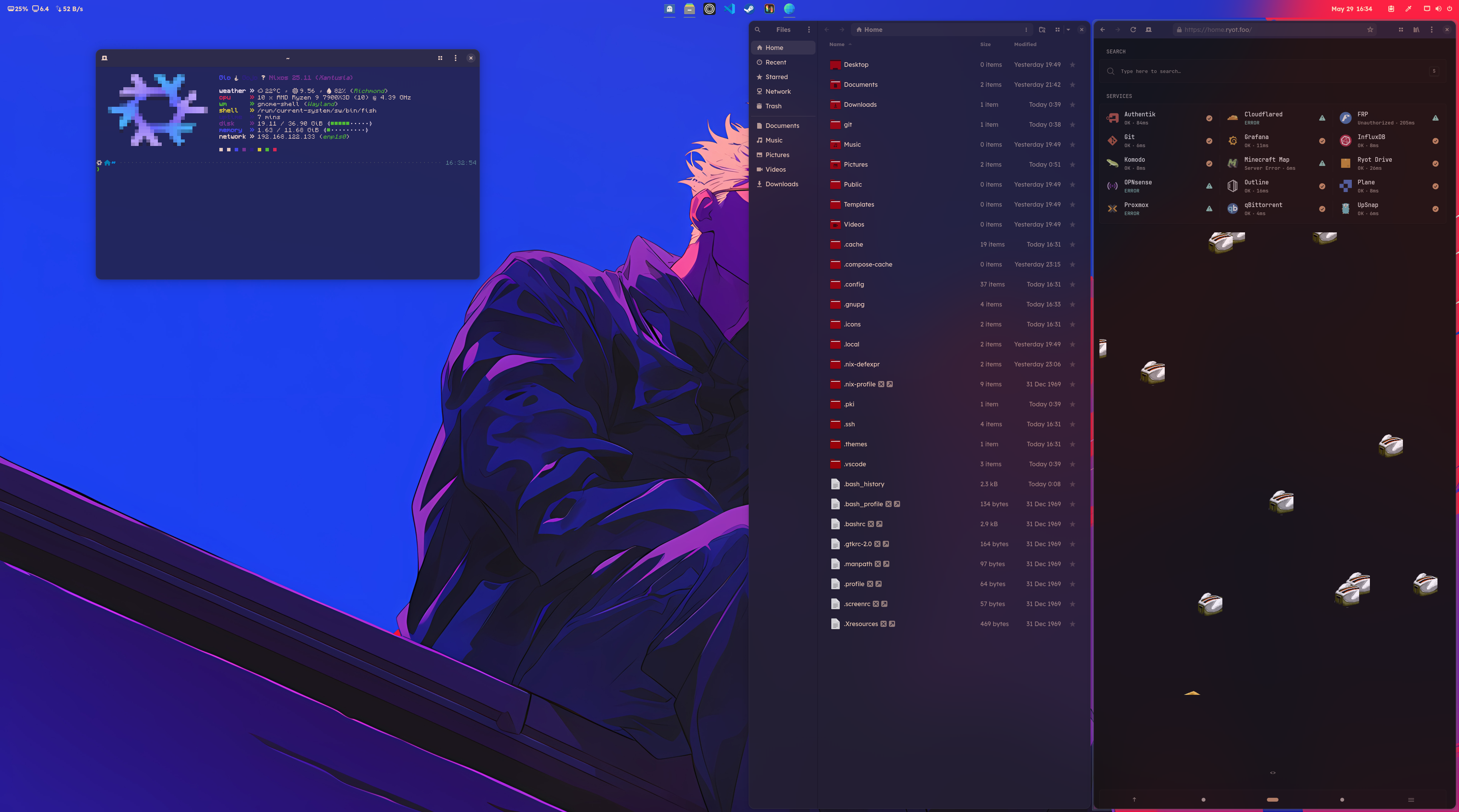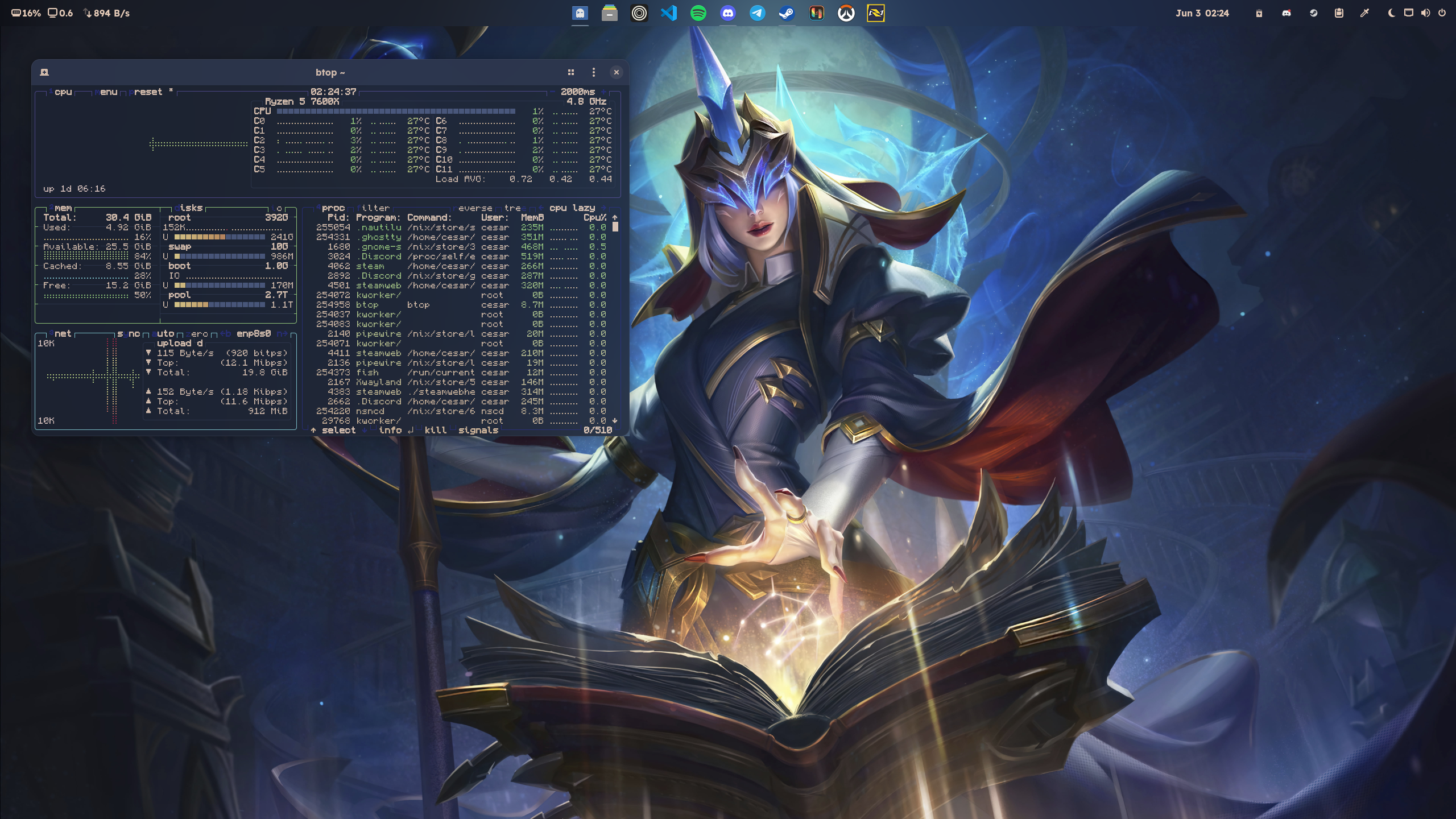| .git-crypt | ||
| .github/workflows | ||
| .vscode | ||
| home | ||
| hosts | ||
| iso | ||
| lib | ||
| modules | ||
| overlays | ||
| pkgs | ||
| .gitattributes | ||
| .gitignore | ||
| flake.lock | ||
| flake.nix | ||
| readme.md | ||
| secrets.nix | ||
| shell.nix | ||
❄️ dot.nix
My NixOS & Home Manager Multi User/Host Configuration
A modular Nix flake managing multiple systems and users with a focus on reproducibility and ease of maintenance.
🏗️ Architecture Overview
This repository follows a layered, modular approach that separates system-level configurations from user environments, while promoting code reuse across different hosts and users.
📁 dot.nix/
├── ❄️ flake.nix # Central entry point & dependency management
├── 🔐 secrets.nix # Encrypted secrets (git-crypt)
├── 🏠 hosts/ # System-level configurations
├── 👤 home/ # User environment configurations
├── 📦 modules/ # Reusable configuration modules
├── 🎨 overlays/ # Package customizations
├── 📋 pkgs/ # Custom package definitions
└── 🛠️ lib/ # Helper functions & utilities
🎯 Core Components
Flake Management (flake.nix)
The heart of the configuration, managing:
- External Dependencies:
nixpkgs,home-manager,stylix,hardware modules,solaar,snapraid-aio,chaotic - System Outputs: Complete NixOS configurations for each host
- Custom Packages: Exposed packages from
pkgs/ - Overlays: Package modifications and additions
Secret Management
- Encryption:
git-cryptsecures sensitive data insecrets.nix - Structure: Defined by
modules/global/secret-spec.nix - Content: SSH keys, API tokens, hashed passwords, SMTP credentials
Configuration Specifications
host-spec.nix: Defines host attributes (hostname, user, hardware type, desktop environment,isMinimalfor server configurations)secret-spec.nix: Structures for secrets, firewall rules, Docker environments, Users, etc- Example secrets.nix
🏠 System Architecture (hosts/)
Global Configurations
hosts/global/
├── core/ # Essential base settings
│ ├── fonts.nix # Font management
│ ├── networking.nix # Network configuration
│ ├── ssh.nix # SSH server setup
│ └── user.nix # User account setup
└── common/ # Optional system features
├── audio.nix # PipeWire audio stack
├── gaming.nix # Steam, GameMode, hardware optimizations
├── gnome.nix # GNOME desktop environment
├── docker.nix # Docker setup
└── libvirt.nix # VM tools and management
Host-Specific Configurations
Each system in hosts/nixos/<hostname>/ contains:
default.nix: Main configuration importing globals + host-specific settingshardware.nix: Hardware-specific configuration (bootloader, filesystems, drivers)config/: Service-specific configurations (optional)
🖥️ Current Hosts
| Host | Type | Purpose | Hardware | Services |
|---|---|---|---|---|
| rune | Desktop | My workstation | Ryzen 9 7900X3D, RX 9070 XT | Gaming, Development, VMs |
| gojo | Desktop | Giovanni's workstation | Ryzen CPU, RX 6950 XT | Gaming, Development |
| haze | Desktop | Cesar's workstation | Ryzen 7, RX 6950 XT | Gaming, Development |
| sock | Server | Backup & Storage | Intel N150 | WIP; Hosted on Firewall |
| cloud | LXC Container | Storage & NFS | 4C/4GB | File storage, NFS server, Backups |
| komodo | LXC Container | Docker orchestration | 12C/30GB | Authentik, Komodo, Web services |
| proxy | LXC Container | Network proxy | 3C/2GB | Cloudflare tunnels, Caddy |
| nix | LXC Container | Development server | 10C/12GB | Remote development, VSCode server |
| vm | VM | Testing environment | Variable | System testing |
👤 User Environment (home/)
Global Home Configurations
home/global/
├── core/ # Essential user tools
│ ├── fastfetch/ # System info shell prompt with custom scripts
│ ├── fish/ # Shell configuration
│ ├── git.nix # Git setup with signing
│ └── ssh.nix # SSH client configuration
└── common/ # Optional user applications
├── gaming/ # Gaming tools & emulator backups
├── gnome/ # GNOME-specific programs & settings
├── vscode/ # VS Code with patched SSH
└── zen.nix # Zen browser configuration
User-Specific Configurations
Each user in home/users/<username>/ includes:
- Theme Configuration: Stylix-based theming with custom color schemes
- Host Adaptations: Per-host overrides in
home/hosts/<hostname>/
👥 Current Users
| User | Theme | Primary Host | Desktop Setup |
|---|---|---|---|
| toph | Invincible (blue/yellow) | rune | GNOME + PaperWM |
| gio | Gojo (red/white) | gojo | GNOME + PaperWM |
| cesar | Soraka (purple/violet) | haze | GNOME + PaperWM |
🎨 Theming & Customization
Stylix Integration
- Unified Theming: Base16 color schemes applied system-wide
- Custom Schemes: User-specific YAML color definitions
- Coverage: GTK, terminal (
ghostty), VS Code (optional), wallpapers - Fonts: Consistent typography (Lexend,
Monocraft Nerd Fonts, Laila)
GNOME Customization
- Window Management: PaperWM for tiling workflow
- Extensions: Blur My Shell, Vitals, Pano clipboard, custom keybindings, ...
- Per-User: Customized dconf settings for each user's workflow
🔧 Notable Features
🎮 Enhanced Gaming
- Optimized Stack: Steam integration with Proton, GameScope, and GameMode.
- Automated Emulator Backups:
borg-wrapperscript (Fish-based) leveragesinotify-toolsandborgbackupfor automatic, incremental save file backups for emulators like Ryujinx.# Example: Automatic save backup for Ryujinx borg-wrapper -p "~/.config/Ryujinx/bis/user/save" \ -o "/pool/Backups/Switch/RyubingSaves" \ -m 30 -- ryujinx - Hardware Tuning: Includes AMD GPU specific settings (e.g.,
lactfor tuning) and Variable Refresh Rate (VRR) support.
🗄️ Robust Storage & Backups
- Centralized Storage (Cloud Host): Utilizes a MergerFS pool for unified drive access, exported via NFS (mounted as
/poolon other hosts). - Data Integrity: SnapRAID provides parity-based data protection for the storage pool.
- Comprehensive Backups: Provides incremental backups of critical data, like Docker volumes and Forgejo instances, with Apprise notifications.
- Automated Backup Chain: Systemd timers orchestrate SnapRAID syncs and Borg backups.
🖥️ Streamlined Desktop & User Experience
- Custom Fish Shell: Enhanced with the Tide prompt,
grcfor colorized output, and some utility functions - Modern Terminal:
ghosttyas the default terminal emulator, themed with Stylix. - Efficient File Management:
yaziconfigured as the terminal file manager. - Curated Applications: Includes configurations for applications like the Zen browser and VS Code.
- XDG & Mime Associations: Sensible default applications configured via
xdg.mimeApps, usinghandlr-regexfor flexibility.
🐳 Container Management
- Komodo Integration: Docker stack management through web UI
- Service Definitions: Authentik SSO, Caddy reverse proxy, various applications
- compose2nix: Docker Compose files converted to NixOS modules
🐳 Advanced Container Management
- Docker Orchestration: Komodo provides a web UI for managing Docker stacks.
- Key Services: Pre-defined declarative configurations for services like Authentik (SSO) and Caddy (reverse proxy).
- Declarative Stacks:
compose2nixis used to convert Docker Compose files into NixOS declarative modules for services like FileRun, Authentik, etc.
🔐 Integrated Security
- Encrypted Secrets:
git-cryptfor managing sensitive data in git. - Secure Remote Access: Cloudflare Tunnels for Zero Trust access to services.
- Automated Certificates: ACME (Let's Encrypt) with DNS challenges for SSL/TLS.
- SSH Key Deployment: Automated management and deployment of SSH keys.
🚀 Usage & Deployment
Initial System Installation
For setting up a new system (in NixOS) with this configuration:
1. Clone Configuration Repository
# Get yay.nix temporarily for installation
nix shell github:Tophc7/yay.nix --extra-experimental-features flakes --extra-experimental-features nix-command --no-write-lock-file
# Clone the configuration repository using yay try
yay try git git-crypt micro
cd ~/Documents/
git clone https://github.com/tophc7/dot.nix
2. Unlock Encrypted Secrets
cd ~/Documents/dot.nix
git-crypt unlock <<path/to/symmetric.key>> # Or use GPG key
3. Configure Hardware Settings
-
Compare hardware configurations:
micro ~/Documents/dot.nix/hosts/nixos/gojo/hardware.nix micro /etc/nixos/hardware-configuration.nix -
Update hardware.nix with the
fileSystemsandswapDevicesfrom the generated/etc/nixos/hardware-configuration.nix
4. Install Configuration (TTY)
- Switch to TTY:
Ctrl+Alt+F2 - Login to TTY
- Rebuild system:
nix shell github:Tophc7/yay.nix --extra-experimental-features flakes --extra-experimental-features nix-command --no-write-lock-file yay rebuild -H gojo -p ~/Documents/dot.nix -e sudo reboot -f
Day-to-Day System Management
Once installed, use the integrated yay tool for all system management:
# Build and switch system configuration
yay rebuild
# Update flake inputs
yay update
# Clean up system
yay garbage
# Try packages temporarily
yay try fastfetch -- fastfetch
# Create archives
yay tar myfiles/
# Extract archives
yay untar myfiles.tar.zst
Environment Variables
FLAKE: Set to your flake directory to avoid using-pflag repeatedlyexport FLAKE="$HOME/Documents/dot.nix" yay rebuild # Will automatically use $FLAKE path
📚 Development Philosophy
Modularity
- Separation of Concerns: System vs. user configurations
- Reusable Components: Shared modules across hosts
- Parameterization: Host specs drive configuration choices
Maintainability
- Structured Secrets: Clearly defined secret specifications
- Documentation: Inline comments and clear naming
- Testing: VM configurations for safe testing
Flexibility
- Multiple Users: Support for different users with different preferences
- Host Adaptation: Same user config adapts to different machines
- Service Composition: Mix and match services per host needs
🔗 Key Technologies
| Category | Technologies |
|---|---|
| Core | NixOS, Home Manager, Nix Flakes |
| Shell | Fish Shell, Tide Prompt |
| Desktop | GNOME, PaperWM, Stylix, Ghostty, Yazi |
| Virtualization | libvirt, QEMU, LXC |
| Storage | MergerFS, SnapRAID, BorgBackup, NFS, inotify-tools |
| Containers | Docker, Komodo, compose2nix |
| Security | git-crypt, ACME, Cloudflare Tunnels |
| Development | VS Code (Patched SSH), nixfmt, biome |
| Gaming | Steam, Proton, GameScope, GameMode, lact |
| Monitoring | Apprise notifications, systemd timers |
📝 Quick Reference
Directory Structure
hosts/nixos/<name>/- System configurationshome/users/<name>/- User environmentshome/hosts/<name>/- Host-specific user overridesmodules/global/- Shared specificationspkgs/- Custom packagessecrets.nix- Encrypted secrets (git-crypt)
Key Files
flake.nix- Dependency management & outputsshell.nix- Recovery environmentmodules/global/host-spec.nix- Host attribute definitionsmodules/global/secret-spec.nix- Secret structure definitions
👥 Credits & Acknowledgments
This configuration is built upon the excellent foundation provided by EmergentMind's configuration. Many core architectural decisions and implementation patterns draw heavily from their work, including but not limited to:
- Host Specification System: The
host-spec.nixpattern andmkHostfunction structure - Modular Architecture: The separation of system and user configurations
A huge thank you to EmergentMind for creating such a well-structured and educational NixOS configuration that serves as my introduction to NixOS and its wonders. Their work made this homelab setup possible and continues to influence It.
This configuration emphasizes reproducibility, security, and maintainability while supporting a complex multi-user, multi-host homelab environment. I quite love it, hope it serves as inspo to some of you out there.
